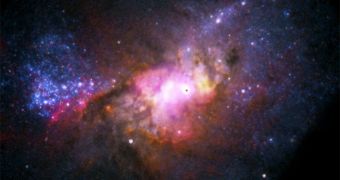In a new study they conducted recently, astronomers were surprised to discover that supermassive black holes can exist at the core of minute, dwarf galaxies as well, and not just at the center of very large ones, such as the Milky Way.
This discovery brings an old, chicken-and-egg-type of question back into the spotlight, as experts try to figure out whether galaxies, or whether the black holes came ahead. Answering this question has until now proven to be more complex than thought.
Over the years, experts have largely stuck to two points of view – that galaxies tend to form around black holes, and that the exact opposite is true, with black holes forming inside their galactic homes.
Scientists have discovered large black holes at the cores of every large galaxy thus far observed. In most instances, the size and mass of the dark behemoth increases with that of its host.
According to experts, the new finding finally shifts the balance towards one camp of the argument. In the new study, investigators were able to discover a very large black hole within a very small galaxy.
The massive object is located inside the dwarf galaxy Henize 2-10. This particular black hole has a mass that is 1 million times larger than that of our Sun, Space reports. What's also very interesting about this galaxy is that it has no central bulge.
Past investigations have linked the existence of such a structure – which can commonly be seen at the core of spiral galaxies – with the size of the black hole the galaxy contains. But this dwarf galaxy features no bulge to speak of.
“This definitely suggests the black hole comes first, because Henize 2-10 is a very low-mass dwarf galaxy without a detectable bulge, yet it does already have a supermassive black hole sitting there," explains scientist Amy Reines.
“So the implication is you don't have to have a bulge to form a black hole,” adds the expert, who was the leader of the new study. Reines is a graduate student at the University of Virginia.
“This result suggests we need to look at more dwarf galaxies similar to Henize 2-10, because right now we just don't know if this is a rare case or if other galaxies like it have their own black holes,” she says.
In order to observe the small galaxy, the research team used the NASA Hubble Space Telescope, the most renowned orbital instrument in the world, and the Very Large Array (VLA) radio observatory.
The latter is operated throughout the United States by the National Science Foundation (NSF). Data from the two observatories were combined to provide the attached view of Heinze 2-10.
Researchers had blind luck in discovering this particular black hole, the team leader says. “It was a completely serendipitous discovery,” she adds.
“I was initially studying the starburst in Henize 2-10 as part of my Ph.D. thesis with no thoughts of black holes,” Reines concludes.
The full details of the recent work were published in the January 9 issue of the esteemed scientific journal Nature.

 14 DAY TRIAL //
14 DAY TRIAL //